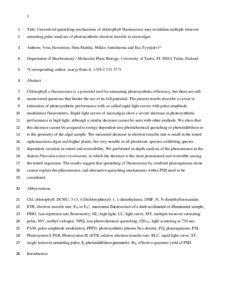Unresolved quenching mechanisms of chlorophyll fluorescence may invalidate MT saturating pulse analyses of photosynthetic electron transfer in microalgae
Havurinne V.; Mattila H.; Antinluoma M.; Tyystjärvi E.
https://urn.fi/URN:NBN:fi-fe2021042719977
Tiivistelmä
Chlorophyll a fluorescence is a powerful tool for estimating
photosynthetic efficiency, but there are still unanswered questions that
hinder the use of its full potential. The present results describe a
caveat in estimation of photosynthetic performance with so-called rapid
light curves (RLCs) with pulse amplitude modulation fluorometers. RLCs
of microalgae show a severe decrease in photosynthetic performance in
high light, although a similar decrease cannot be seen with other
methods. We show that this decrease cannot be assigned to
energy-dependent non-photochemical quenching or photoinhibition or to
the geometry of the algal sample. The measured decrease in electron
transfer rate is small in the tested siphonaceuous algae and higher
plants, but very notable in all planktonic species, exhibiting
species-dependent variation in extent and reversibility. We performed
in-depth analysis of the phenomenon in the diatom Phaeodactylum
tricornutum, in which the decrease is the most pronounced and reversible
among the tested organisms. The results suggest that quenching of
fluorescence by oxidized plastoquinone alone cannot explain the
phenomenon, and alternative quenching mechanisms within PSII need to be
considered
Kokoelmat
- Rinnakkaistallenteet [27094]
